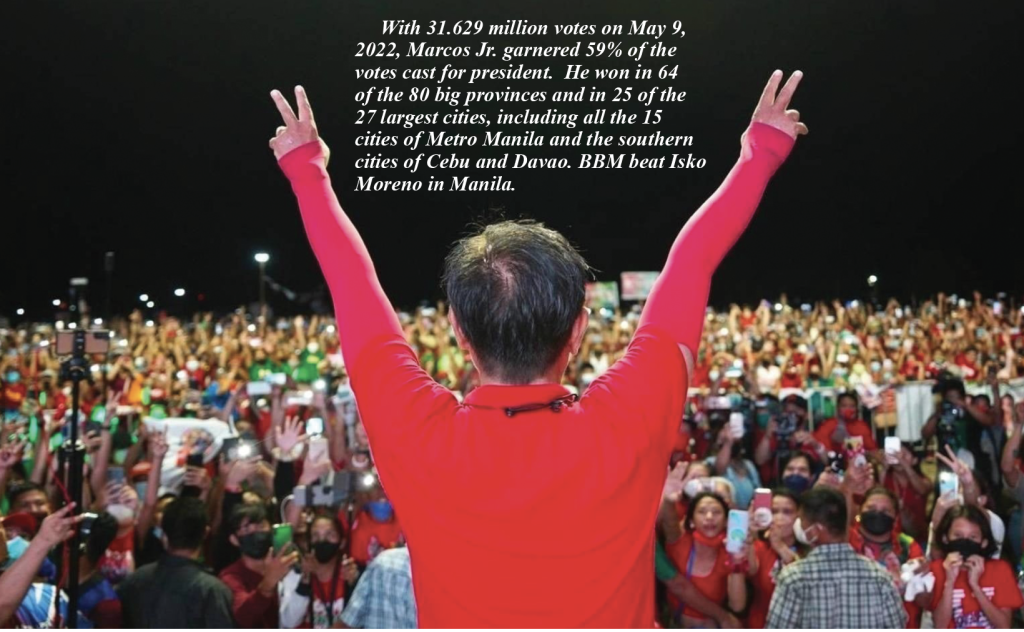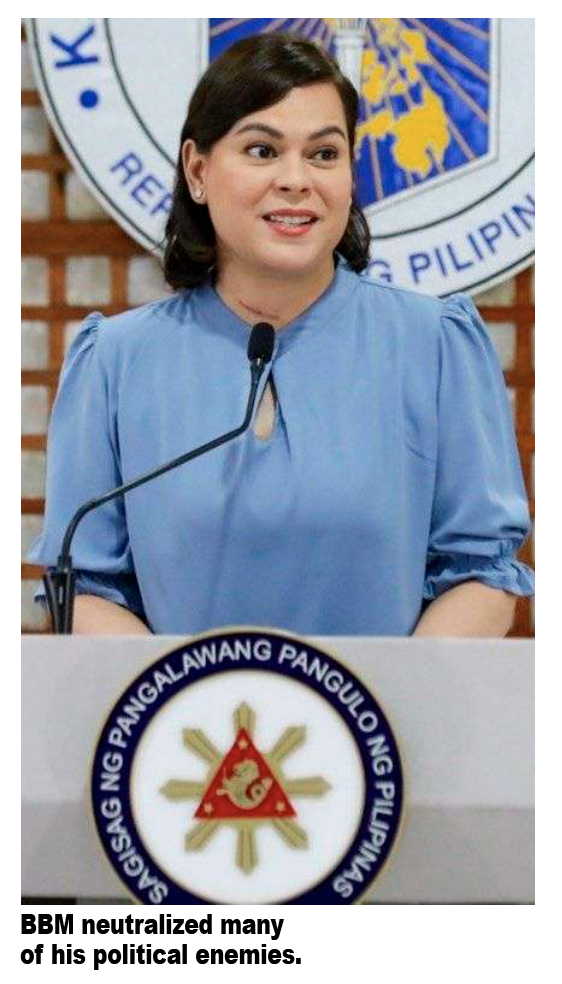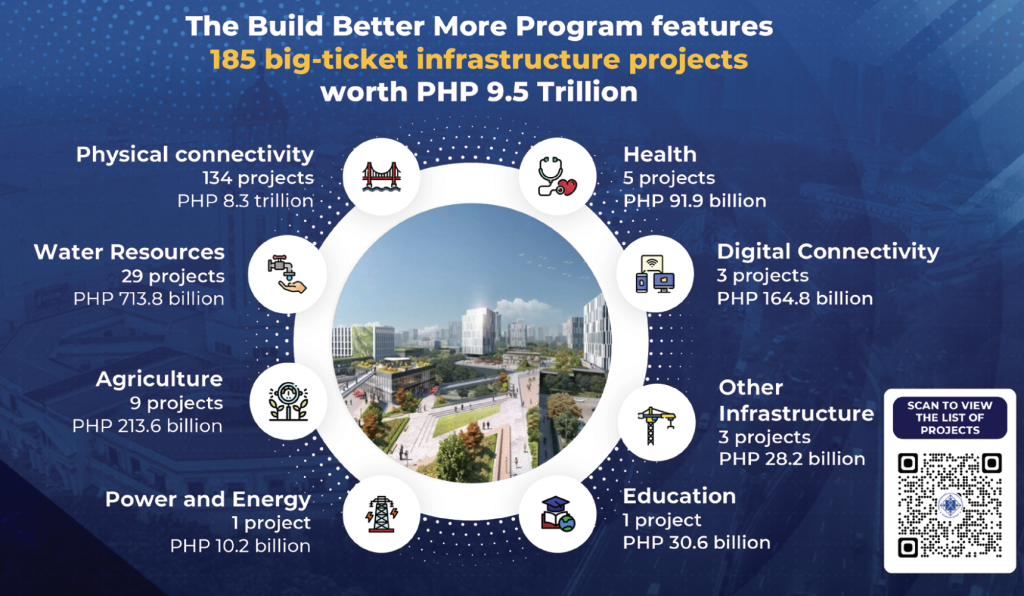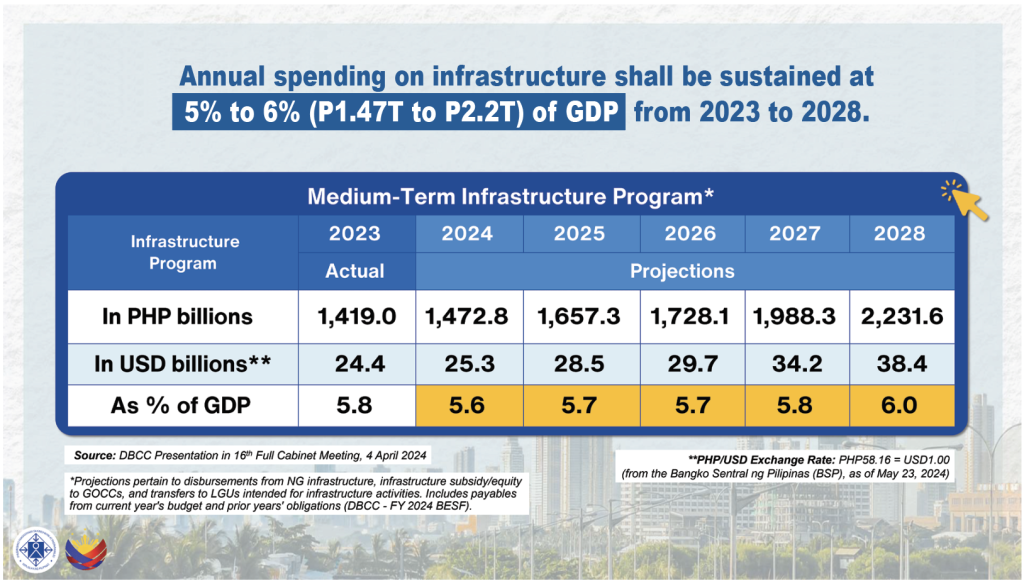
By Tony Lopez
On June 30, 2024, Ferdinand “Bongbong” Romualdez Marcos Jr. completed the first two years of his six-year presidency.
In two years, Marcos Jr. did five things:
One, he unified the country.

Two, BBM has focused on the economy and infrastructure, the “Build Better More” (BBM) program.
Three, BBM neutralized many of his political enemies.
Vice President Sara Duterte is out of the cabinet, denied travel, intelligence, and discretionary funds. She will be a non-starter in the 2028 elections which a broadcaster could probably win, unless a relative snags the presidency.
Four, BBM travelled a lot, making 24 trips to 17 countries. The trips generated $72.2 billion in investment pledges (as of end-2023), which if they materialize would make every Filipino upper income overnight.
Pivot to America
Five, BBM executed a pivot to America and made China Public Enemy No. 1 of the Filipino people.
He has offered Washington DC up to 12 military bases from which to deploy armor, missiles, ships, aircraft, and –troops, despite what the Philippine Constitution says to the contrary on foreign military bases and nukes.
Marcos Jr. is the first president elected by the majority of Filipinos, since the last majority presidential winner, Ferdinand Edralin Marcos Sr. in 1969.
With 31.629 million votes on May 9, 2022, Marcos Jr. garnered 59% of the votes cast for president. He won in 64 of the 80 big provinces and in 25 of the 27 largest cities, including all the 15 cities of Metro Manila and the southern cities of Cebu and Davao. BBM beat Isko Moreno in Manila.

The second presidential placer, Leni Robredo won in just 14 provinces. Third placer Manny Pacquiao won in one province.
“In nearly four decades, we endured being mocked and oppressed,” recalled elder sister, Senator Imee Marcos Manotoc who joined her only brother at the rostrum for his proclamation after the May 2022 election. “We are grateful for this second chance.” Ironically today, Ate lmee sounds more like a member of the disparate opposition parties than of the ruling Ang Bagong Pilipinas class.
On the economy, from a modest 5.5% growth this year, the administration targets minimum average economic growth of 6.5% per year til 2028, with 8% the high target for the years 2026, 2027, and 2028, despite worsening geopolitical tensions and growing trade wars.
Whether by luck, by accident or by design, the Philippines is today ASEAN’s fastest growing economy, “a leading force among Asia’s emerging economies.”
“Our first quarter GDP growth rate is about the same as Vietnam’s, surpassing other major economies such as China at 5.3%, Indonesia at 5.1%, and Malaysia at 3.9%, but slower than India’s projected growth rate of 6.2%,” says Economic Planning Secretary Arsenio Balisacan.
From double digits, poverty will be cut to 9%, or 14 million Filipinos rescued from the misery of earning just $2 every day.
“The Philippine economy’s dynamism is anchored on strong consumer demand supported by a vibrant labor market,” says Finance Secretary Ralph Recto. “With our arsenal of growth-enhancing strategies, this administration has the right policy tools and determination to take us to $6,500 income by 2030,” vows Recto. In 2033, he predicts, “the Philippines will be a $1 trillion economy.” Filipinos will be trillionaires, in dollar terms. “We have a bold and decisive leader,” Recto shrugs off cynics.
Under his BBM infra, Marcos Jr. has lined up 185 infrastructure flagship projects that would cost a whopping P9.54 trillion ($164 billion), which, if carried out, will be the largest infrastructure rollout in the country’s history.
The 185 consist of 134 physical connectivity projects costing $142.2 billion; 29 water projects, $12.3 billion; nine agriculture, $3.7 billion; five health, $1.6 billion; three digital connectivity, $2.8 billion; one power and energy, $0.2 billion; one education, $0.5 billion; and three other projects, $0.5 billion.
Only half of the 185 projects have a good chance of being started and/or completed.
Puzzling is the sparse allocation for energy projects — $200 million, and education infra, $500 million.
We have a severe energy crisis. Within five years according to forecasts by SMC, additional power capacity needed is between 69,000 megawatts and 92,000 megawatts, an investment of $184 billion. Who will provide that money?
Meanwhile, our 15-year-olds are rated among the most stupid teeners on earth.
They cannot read, they cannot count beyond 20, and they are not at all creative. Just like monkeys.
Where will BBM get most of the money, the P9.54 trillion? Well, from borrowings, and from our taxes. Since borrowings will be paid with taxes, Filipinos will shoulder the brunt of the cost. Only five of 82 identified projects have private sector participation. So expect tax measures to come our way.
To entice private companies to undertake the 185 projects, BBM has shortened the processing time for unsolicited projects under the new Public Private Partnership (PPP) Code, from 26.5 months to – 16.9 months for local PPPs and 14.9 months for national PPPs.

MOPC Investment Night
The Manila Overseas Press Club (MOPC) held its “Investment Night”, Tuesday, June 25, at the Fairmont Makati ballroom. Senior journalists, diplomats, and top businessmen heard the Economic Czar Frederick Go report on investments and the economy.
Secretary Deck Go built from scratch Robinsons Land Corp., one of the largest and most innovative property conglomerates in revenues, number of projects, and project size, with a record of solid growth and profitability, assets of P228 billion, equity of P130 billion, and market value of P75 billion.
Deck brings his over three decades of entrepreneurial experience to public service as the Economic Czar to create a healthy business climate and bring about investments that are real, profitable, and will touch the lives of ordinary Filipinos.
